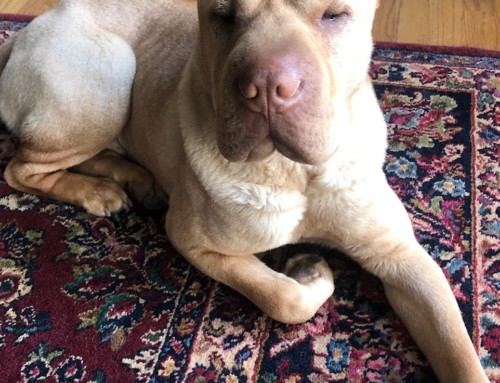One morning I woke up to find that Little Mama, the sweet stray cat I’d recently taken in, wasn’t dashing towards the food bowl with my other cat the second I emerged from the bathroom. Mystified, I saw her lying on the kitchen floor, looking wan and disinterested. I called out to her, but, when she eventually tried to move, her back legs wouldn’t support her and she’d just plop down again onto the tile. I was concerned, thinking she may have injured her legs jumping or running away from my other cat. I tried calling a number of vet offices, most of which I learned were closed on Saturdays. A Pet Smart Banfield vet, however, was able to squeeze her in for an appointment. I then did what a lot of folks do but probably shouldn’t: trolled the web for information in the hopes that I would find that the issue was common and/or treatable. Instead, I very quickly found out that in cats, a condition known as aortic thromboembolism can sometimes be attributed to sudden loss of use in the hind legs and will usually end in extreme pain and almost immediate death. Horrified, I began counting the minutes until we could leave. I gingerly placed her in a carrier and drove to PetSmart. Six hours – and hundreds of dollars – later, we drove home with more bad news. The Banfield vet and her staff had been thoroughly perplexed; the blood work and X-rays had shed no light on the misuse of her legs. They had, however, learned she was positive for heartworm, a death sentence for cats if one were to believe the internet. They advised me that if she continued to avoid food and water it would be best to put her down. The doctor also advised that if I wanted to find out more, I would need to enlist a specialist, which would entail X-rays and other procedures that may or may not reflect anything at all and would probably cost a thousand dollars or more. I knew I couldn’t afford it. By the time I got home that night, I was already convinced that I would have to put down my Little Mama, who’d had such a hard life already. I gave her the anti-inflammatory medicine they’d grudgingly decided MIGHT help her until her legs healed, and spoiled her as much as possible, acknowledging the futility of the situation and trying to say goodbye.
Two days later – and with no improvement in Little Mama’s legs or demeanor – I arrived to work and told my co- worker, Peggy, about what had happened. Peggy, a devout client of Dr. Moorehead’s, persuaded me that I should take her to see him. They fit me in for later that afternoon, and poor Little Mama had to be shut up in the carrier once again. I arrived at the doctor’s, and the vet tech explained the NRT procedure. Dr. Moorehead came in, reiterated the procedure, and eyeballed Mama while she crawled around the floor. He asked some questions, expressing a kind disapproval at my hopelessness, then he and the vet tech began.
I had to admit I was skeptical; the procedure looked a bit hokey: no needles, no samples, no prodding, just a man holding small mystery bottles, one by one, against his patient. The tech stood by silently as a type of conductor, barely touching Mama while simultaneously holding an arm out so that the doctor might sense Mama’s reaction to whatever substance he placed next to her body. I had the same feeling one might get while watching someone pan for gold or perform a séance: hesitant of the method, hopeful of the outcome, all with the conscious acknowledgment that failure would at least do no more harm. After he determined that her kidneys needed some help, he prescribed some supplements for her. In a few days, Mama was walking fine. I’m still not exactly sure what this kind, intelligent man actually did to my cat, but what he did for her worked. I’ll never forget that he had expressed hope for her life while I was so focused on her death. One year later, Mama is doing fine; she hops, runs, and plays, heartworm and death sentence aside. I’m still taking my little one there for visits, and have learned my lesson about “lost causes.”
Sincerely,
BM




